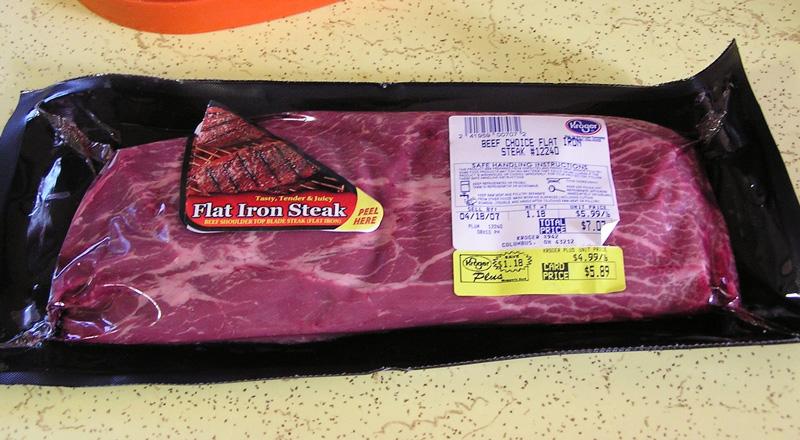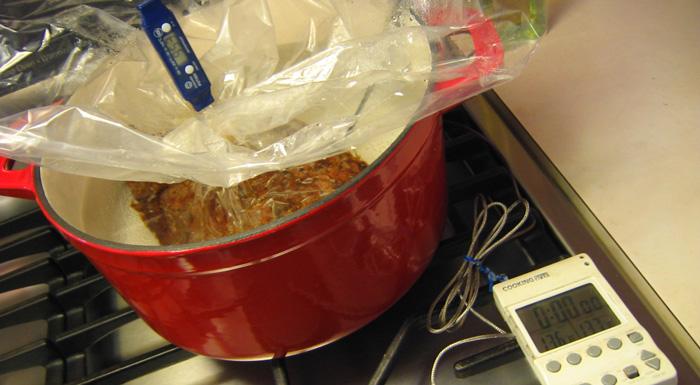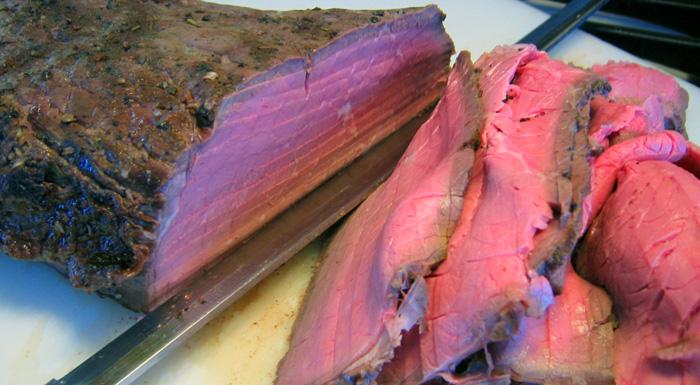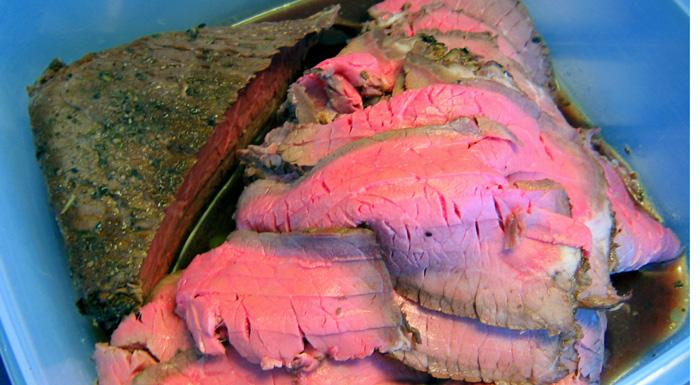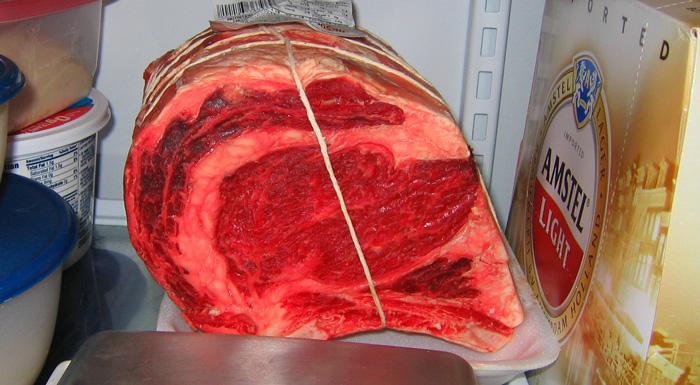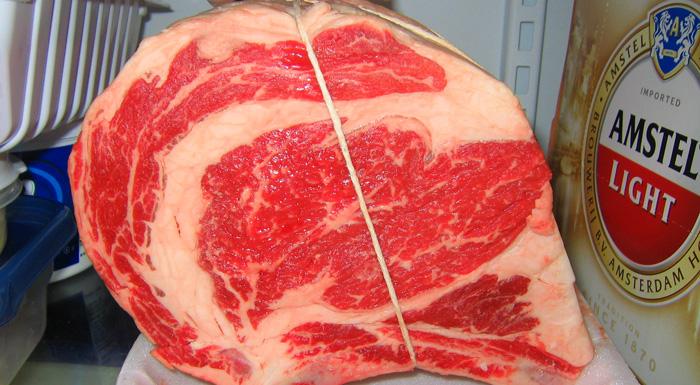-
Posts
717 -
Joined
-
Last visited
Content Type
Profiles
Forums
Store
Help Articles
Everything posted by ChefCrash
-
This cut is regularly sold at Kroger in this package: It is quite tender. I like to use it for Cheese steak sandwiches and stir fries. I don't know if the meat is injected with anything, It's very juicy and tends to release a lot of liquid.
-
Roast beef sandwiches made with leftover rib roast from this past Christmas were so good we had to have more. Last night I picked up a top round roast. The plan was to make it the same night to take to work today. Last night's dinner however, was to be pizza and I couldn't occupy the oven for three hours with the roast. This presented the perfect opportunity to argue for a second, in-wall oven. She countered: "wouldn't it be cheaper to buy you a coupon for a life time supply of roast beef"? (insert attitude) She'd said the same thing when I wanted to buy the Berkel VCMA/1 3 phase 188 Cup Dough Maker so we could save money on take-out pizza. I now have a coupon for a life time supply of dough from Papa Johns. So, I decided to make stove-top-roast sousvide (red neck sousvide if you will) . I had done this 5 years ago (click here) and here with an electric stove. The lowest temperature I could maintain was about 150*F. Now we have a gas stove with a nice simmer burner. This is what I did this time. I didn't want to sear the roast in a pan because splatter on continuous grates means continuous cleaning. So, straight out of the fridge, I seasoned the roast, turned the oven broiler to HI, placed the roast on a 1/4 sheet pan lined with foil and placed that on the top rack. It took 5 to 7 minutes to brown each side. One must be careful here. Any fat melting into the pan can catch on fire (I caught mine in time). I put the roast in an oven bag following the same steps as before. I had a 150*F pot of water ready. After submerging the bag-o-roast, the temperature equalized to 132*F. I turned up the heat to bring water temperature to 135*F then lowered the burner all the way. I only had to make minor adjustments once or twice to maintain temperature. About 2.5 hours later internal temperature reached 136*. I pulled the bag, placed it in a deep dish, and in the fridge it went. This morning I poured the liquid into a Tupperware container (about 1/2 cup) and sliced most of the roast. Note that the browning only penetrated a 1/4" and the uniform color through the slices. All sliced and back in the jus. At work, individual servings were slightly heated in the microwave and sandwiched between slices of cheap white bread smeared with Kraft horseradish sauce and watercress.
-
How are you keeping it in the fridge ? Is it on a rack, atop a tray, covered or uncovered ? Please give a few details. edited for grammer (of course:) ) The photo above, is of how the roast is in the fridge. The following photo is of how it looks today.
-
What no answers? The article from which the following quotes were obtained This dude assumes potatoes are like sponges. Which explains why he didn't bother tell us the ratio of potato to water he used. Understandable, since sponges or "six, 1/4" slices of potato totaling 300 square centimeters of surface area", (which amount to a cylinder slightly larger than a silver dollar, 1.5" long), dipped into a saline solution, only remove "suck", part of the solution leaving the remainder with the same salinity/conductivity. But what if the sponge is 80% water saturated before it's dipped in the salted water? Potatoes are 80% water! He's not sure if he had evaporation? I don't understand the last paragraph at all. I hope he's not holding his breath. My results tomorrow.
-
It's that time of year again. Well marbled 9.2 pounds, choice rib roast. It's aging in the fridge (one week). Will be rubbed with mashed garlic and oil and seasoned with Thyme, Rosemary, cracked pepper and lots of kosher salt. It will roast at 200*F.
-
Hi Let me first say that what led me to do this had more to do with people's claims (including some TV personalities), that potatoes don't absorb salt, or benefit from being boiled in salted water, than whether they can be used to correct a mistake. I was trying to hit two birds with one stone. So far, can we all agree that potatoes do absorb salt., and that potatoes don't act as sponges as Wolke suggests? Let me answer some questions Before electricity my ancestors only had a Hydrometer to check salinity of brines, it was in the form of a floating egg. I agree, potatoes don't posses special qualities. Just that they're relatively inexpensive and usually are at hand and minimally alter the taste of whatever one is trying to rescue. Obviously, the salt removed from this exaggerated salt to water ratio was not going to have a discernible difference to me. Now a question for Nick and Chris, what are the effects of starch interactions with salt in a solution? Are we talking about the fact that starch has a S.G. of half that of water (0.6), and that it's release into the solution causes it to further dilute it giving us erroneous results? If so, I repeated the experiment. This time the way Jaz did (with a little more control). I will post results tonight. Gotta go to work.
-
This has been discussed in at least two threads, here and now here. Some claim it works, others don't agree, some claim potatoes don't even absorb salt. Into a 2 qt. pan I measured 1 Liter (1 Kilo) of tap water. In that, I dissolved 118 grams of canning salt. Why 118 grams/liter? It's a solution I often use for pickling and knew it's specific gravity using my hydrometer. Water weight = 1000g Pot weight = 534g Salt weight = 118g Total = 1652g Potato weight= 446g Total = 2098g Hydrometer read 18.5 *brix (Bx) I quartered 446g potatoes Added them to the water. The soup was brought to a boil then simmered slowly for 30 minutes. I made sure the potatoes were as tender as possible yet firm enough to rescue from the pot without falling apart. Before removing the potatoes the pot was weighed. So far 296g were lost to evaporation. The potatoes were drained and weighed. They lost 14g. We don't care where they went, more importantly they didn't absorb water as this person claims. I should have immediately weighed the pan without the potatoes, but wanted the solution to cool to 85*F before taking a S.G. reading. My wife and I used the time to conduct a taste test (more on that later). Twenty minutes had elapsed. Evaporation as well as water lost in the screen of the strainer (even though I tried hard) might explain why I lost 48g (above and beyond) in this photo. Enough fresh water (212g) was added to the soup to replace lost water and sampled in the hydrometer.(here I made a big mistake, see who can spot it). The reading is 15*Bx. What does it all mean? Well, if a one liter solution containing 118g = 17.7 tsp salt registers 18.5* Bx, then a solution registering 15* Bx contains 14.35 tsp salt. A difference of 3.35 tsp or 22.3g salt. Where did the salt go? The taste test I took 2 of the largest pieces of potato. Ones that were not pocked for doneness. I used a sharp knife to reach the core. The outer layers were inedible. The core tasted a little salty for my wife and just salty enough for me. Conclusion? First let me address the mistake mentioned above. When I replenished the solution with fresh water, I added 212g of water based on a total pot weight of 1534g which was pot+water. The actual total weight should have been: pot+water+salt=1652g. So, an additional 118g of water should have been added to reconstitute the soup. I needed to add 330g of fresh water to bring the total weigh back to a kilo. Calculations prove that a total of over 3 tsp of salt were removed by the potatoes.
-
Maybe the scores didn't come out the way the producers wanted?
-
I think the roux in the recipe should be sufficient, otherwise a flour slurry or beurre manie could be used.
-
Hi Scott Try using this: H = kA (dT/dx) from here. H = heat flow rate Cal/s k = thermal conductivity A = area of slab dT = oven temperature minus center of slab temperature dx = 1/2 thickness of slab Then use that to calculate time to reach equilibrium.
-
It's easy, the secret is to periodically (~every 30 seconds or so), shake the peel/pizza loose, as you assemble the topping. If for any reason it doesn't shake loose, place the tip of a drinking straw under the pizza edge and blow to loosen the dough from the peel and shake again.
-
Do you do this in a dish, or in paper packets....How? And are they filets, or whole fish? Place fillets of Cod or similar fish in Pyrex dish (best if you use a dish the same size as the fillets arranged in one layer). Dot with butter. Season with Lemon Pepper OR lemon juice (or whatever). Cover tightly with cellophane. Microwave (just before service) until fish is opaque and flaky. Drizzle with Hollandaise sauce.
-
Nice job Chris, here's another way to truss:
-
Hi Jeff Don't freak out Your olives are undergoing a fermentation process. Your jars should not be sealed. Loosen the covers so gasses (CO2) can escape. Would love to see some photos. We'll be making some this weekend, and I'll post here.
-
I would not go (again) with a cook top that has a stainless or light colored surface under the grates. Any kind of cooking will require that you remove the grates to clean after every meal. The surface eventually gets scratched and discolored. I'd go with one that has a black finish or better, a cast iron surface. If you haven't yet, check out these videos of the Blue Star brand.
-
Here's a short video.
-
Some old ones on ebay or one new on this site.
-
I brought this one with me from Lebanon. It's got a fuel tank at the bottom fitted with a fueling cap, a relief valve and a pump. On top is the head. Fuel reaches the head through the stem and flows through the "Y" shaped tubes, where it's heated by the priming process, vaporizes (reaches flash point temperature) and heads downward through the "U" shaped tube and out of the jet, mixes with air and burns. Coleman camping fuel (odorless kerosene) and rubbing fuel for priming. The little well below the head is filled with alcohol and lit. The relief valve closed. Thirty to sixty seconds later, back pressure builds and the thing roared to life. I pumped the stove three times to get the nice blue flame. The three pump strokes were all that's needed to keep it going for the half hour this batch of fries took to cook (Robuchon method). The setup. Yes, it's July and we still have to were a sweater. Perfect fries every time. So far I have used the stove 3 full hours on a pint of fuel. I love this thing.
-
Mix Tahini with Carob molasses until you have the color of chocolate milk and enjoy on toast.
-
We will be there from May 15th to the 30th. It's been five years since our last visit. Our goals: In Beirut: -Make Manaeesh (Zaatar pies) at the neighborhood bakery. -Visit a restaurant that serves Hummus and Foul Mudammas for breakfast, made fresh in front of us and served hot. -Visit a restaurant called "La Tabkha" because the name is funny. -Lunch at the "Istambuli" near Hamra st. for the best fat kabobs (Leyeh). -Lunch at the best Fish restaurant in Junieh by the sea. -Dine every night in the street cafes of down town Beirut. -Eat shawarma at the Muhatta restaurant in Damour. -Bribe Muhatta employee for shawarma recipe. -Visit a chicken sandwich (pannini) stand. -Solicit Thoumieh recipe. -Visit Basturma and Sujoq stands on Arax Ave in Bourj Hammoud. In Deirmimas (southern Lebanon). -Loquats are in season which attract delicious birds. We will hunt some for breakfast. -Aqub will be just out of season, but my in laws froze a batch just for us. -Will have a picnic under an Olive tree. A one day visit to Damascus: -Visit the "Hamedeyeh Souq" and the "Seven Seas Ave" areas where street vendors dish out some of the best Shawarma, Lahem Mishwi and killer Egg sandwiches. I hope they still have those. Three days in Nicosia: I don't recall much of Cypriot cuisine. Last time there we were Honeymooning and were busy. We will sample foods in the cafes in the folksy areas (Ledra and Salonos st.) I'd like to bring back a terracotta skillet and a "Babbour" (old kerosene camp stove). If you have any suggestions please let me know. There will be a bucket of chilled Almaza Beer waiting for me at Beirut Intl. Will report in 15 days.
-
Perhaps a combination of a simmer too gentle in an uncovered pot with a large surface area, is keeping the temperatures warm enough for the meat to cook but not hot enough for the carrots (as Dougal mentioned).
-
That's because what you see in the photo is (should be) cayenne pepper. The well is formed using the pestle with which the Hummus was mashed.
-
If you've always wanted a lid for the 12" frying pan and also want an All Clad nonstick 12" pan, you can get both for $99 at Williams-Sonoma.



